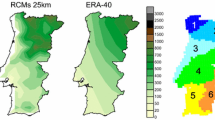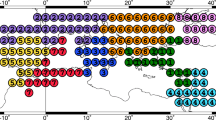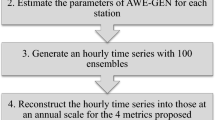Abstract
Since single-integration climate models only provide one possible realization of climate variability, ensembles are a promising way to estimate the uncertainty in climate modeling. A statistical model is presented that extracts information from an ensemble of regional climate simulations to estimate probability distributions of future temperature change in Southwest Germany in the following two decades. The method used here is related to kernel dressing which has been extended to a multivariate approach in order to estimate the temporal autocovariance in the ensemble system. It has been applied to annual and seasonal mean temperatures given by ensembles of the coupled general circulation model ECHAM5/MPI-OM as well as the regional climate simulations using the COSMO-CLM model. The results are interpreted in terms of the bivariate probability density of mean and trend within the period 2011–2030 with respect to 1961–1990. Throughout the study region one can observe an average increase in annual mean temperature of approximately +0.6K and a corresponding trend of +0.15K/20a. While the increase in 20-year mean temperature is virtually certain, the 20-year trend still shows a 20% chance for negative values. This indicates that the natural variability of the climate system, as far as it is reflected by the ensemble system, can produce negative trends even in the presence of longer-term warming. Winter temperatures are clearly more affected and for both quantities we observe a north-to-south pattern where the increase in the very southern part is less intense.





Similar content being viewed by others
References
Bröcker J, Smith L (2008) From ensemble forecasts to predictive distribution functions. Tellus A 60(4):663–678. doi:10.1111/j.1600-0870.2008.00333.x
Buser C, Künsch H, Lüthi D, Wild M, Schär C (2009) Bayesian multi-model projection of climate: bias assumptions and interannual variability. Clim Dyn. doi:10.1007/s00382-009-0588-6
Collins M (2007) Ensembles and probabilities: a new era in the prediction of climate change. Philos Trans R Soc A Math Phys Eng Sci 365(1857):1957–1970
Easterling D, Wehner M (2009) Is the climate warming or cooling? Geophys Res Lett 36(8):L08,706, 0094-8276
Enke W, Deutschländer T, Schneider Füchler W (2005a) Results of five regional climate studies applying a weather pattern based downscaling method to ECHAM4 climate simulation. Meteorologische Zeitschrift 14:247–257. doi:10.1127/0941-2948/2005/0028
Enke W, Schneider F, Deutschländer T (2005b) A novel scheme to derive optimized circulation pattern classifications for downscaling and forecast purposes. Theo Appl Climatol 82(1):51–63. doi:10.1007/s00704-004-0116-x
Fortin V, Favre AC, Said M (2006) Probabilistic forecasting from ensemble prediction systems: improving upon the best-member method by using a different weight and dressing kernel for each member. Q J R Meteorol Soc 132(617):1349–1369. doi:10.1256/qj.05.167
Frame DJ, Faull NE, Joshi MM, Allen MR (2007) Probabilistic climate forecasts and inductive problems. Philos Trans R Soc A Math Phys Eng Sci 365(1857):1971–1992
Gneiting T, Raftery AE, Westveld AH, Goldman T (2005) Calibrated probabilistic forecasting using ensemble model output statistics and minimum CRPS estimation. Mon Weather Rev 133(5):1098–1118
Green P, Silverman B (1994) Nonparametric regression and generalized linear models: a roughness penalty approach. Chapman and Hall/CRC, London/Boca Raton
Hastie T, Tibshirani R (1990) Generalized additive models. Chapman and Hall/CRC, London/Boca Raton
Honerkamp J (2002) Statistical physics: an advanced approach with applications, 2nd edn. Springer, Berlin
Jones R, Yohe G (2008) Applying risk analytic techniques to the integrated assessment of climate policy benefits. Integr Assess Jl 8(1):123–149
Kattsov V, Källén E (2005) Future climate change: modeling and scenarios for the arctic. In: Arctic Climate Impact Assessment (ACIA), Cambridge University Press, Cambridge, UK, pp 99–150
Kreienkamp F, Spekat A, Enke W (2009) Sensitivity studies with a statistical downscaling method—the role of the driving large scale model. Meteorologische Zeitschrift (accepted)
Min SK, Hense A (2006) A Bayesian assessment of climate change using multimodel ensembles. Part I: global mean surface temperature. J Clim 19(13):3237–3256
Min SK, Hense A (2007) A Bayesian assessment of climate change using multimodel ensembles. Part II: regional and seasonal mean surface temperatures. J Clim 20(12):2769–2790
New M, Lopez A, Dessai S, Wilby R (2007) Challenges in using probabilistic climate change information for impact assessments: an example from the water sector. Philos Trans R Soc A Math Phys Eng Sci 365(1857):2117–2131
Raftery AE, Gneiting T, Balabdaoui F, Polakowski M (2005) Using Bayesian model averaging to calibrate forecast ensembles. Mon Weather Rev 133(5):1155–1174
Rockel B, Will A, Hense A (2008) The regional climate model COSMO-CLM (CCLM). Meteorologische Zeitschrift 17:347–348. doi:10.1127/0941-2948/2008/0309
Roeckner E, Bäuml G, Bonaventura L, Brokopf R, Esch M, Giorgetta M, Hagemann S, Kirchner I, Kornblueh L, Manzini E, Rhodin A, Schlese U, Schulzweida U, Tompkins A (2003) The atmospheric general circulation model ECHAM5. Part I: model description. Tech. Rep. 349, Max Planck Institute for Meteorology
Schölzel C, Friederichs P (2008) Multivariate non-normally distributed random variables in climate research—introduction to the copula approach. Nonlin Processes Geophys 15(5):761–772, nPG 1023-5809
Silverman B (1986) Density estimation for statistics and data analysis. Chapman and Hall/CRC, London/Boca Raton
Solomon S, D Qin, Manning M, Chen Z, Marquis M, Averyt K, Tignor M, Miller H (2007) Climate change 2007: the physical science basis. Cambridge University Press, Cambridge
Stainforth DA, Allen MR, Tredger ER, Smith LA (2007a) Confidence, uncertainty and decision-support relevance in climate predictions. Philos Trans R Soc A Math Phys Eng Sci 365(1857):2145–2161
Stainforth DA, Downing TE, Washington R, Lopez A, New M (2007b) Issues in the interpretation of climate model ensembles to inform decisions. Philos Trans R Soc A Math Phys Eng Sci 365(1857):2163–2177
Tebaldi C, Knutti R (2007) The use of the multi-model ensemble in probabilistic climate projections. R Soc Lond Philos Trans Ser A 365:2053–2075
Tebaldi C, Smith RL, Nychka D, Mearns LO (2005) Quantifying uncertainty in projections of regional climate change: a Bayesian approach to the analysis of multimodel ensembles. J Clim 18(10):1524–1540
Wilks D, Hamill T (2007) Comparison of ensemble-MOS methods using GFS reforecasts. Mon Weather Rev 135:2379–2390
Wilks DS (2006) Comparison of ensemble-MOS methods in the Lorenz ’96 setting. Meteorol Appl 13:243–256
Acknowledgements
This work is part of the PArK project which is supported by the Landesanstalt für Umwelt, Messungen und Naturschutz Baden-Württemberg (LUBW). The authors acknowledge the assistance of F. Kreienkamp, A. Spekat, and W. Enke of CEC Potsdam GmbH with respect to providing WETTREG data. The authors would also like to credit the contributors of the R project.
Author information
Authors and Affiliations
Corresponding author
Rights and permissions
About this article
Cite this article
Schölzel, C., Hense, A. Probabilistic assessment of regional climate change in Southwest Germany by ensemble dressing. Clim Dyn 36, 2003–2014 (2011). https://doi.org/10.1007/s00382-010-0815-1
Received:
Accepted:
Published:
Issue Date:
DOI: https://doi.org/10.1007/s00382-010-0815-1




